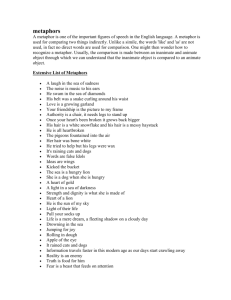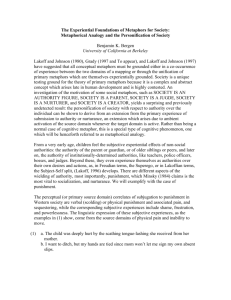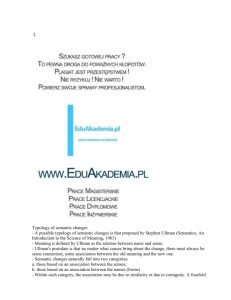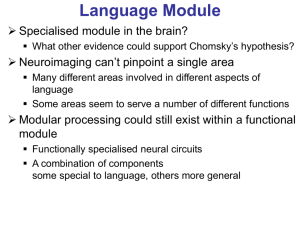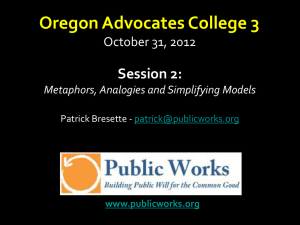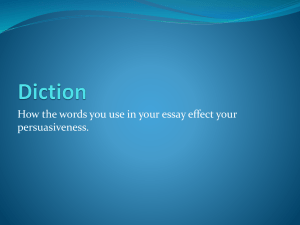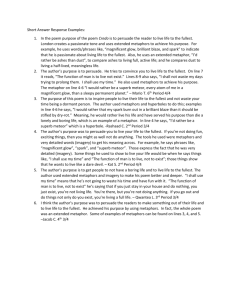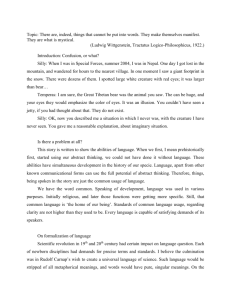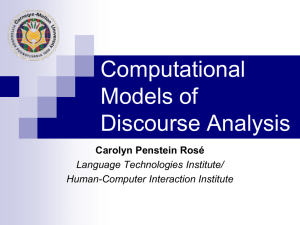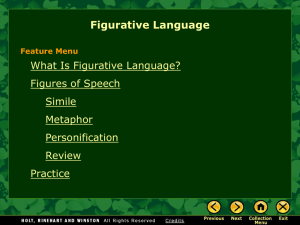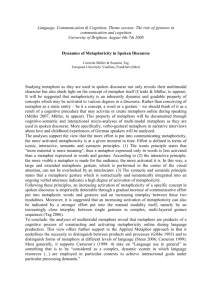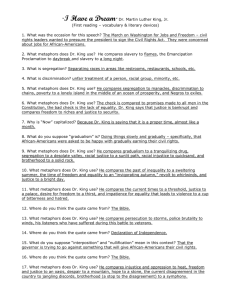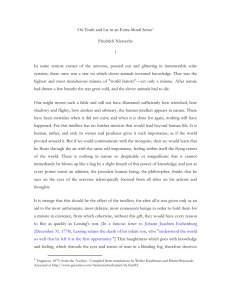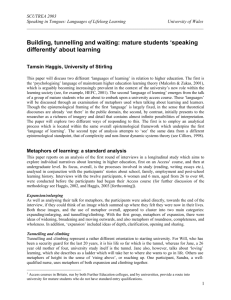TCR.EducationWarsMetaphorically
advertisement
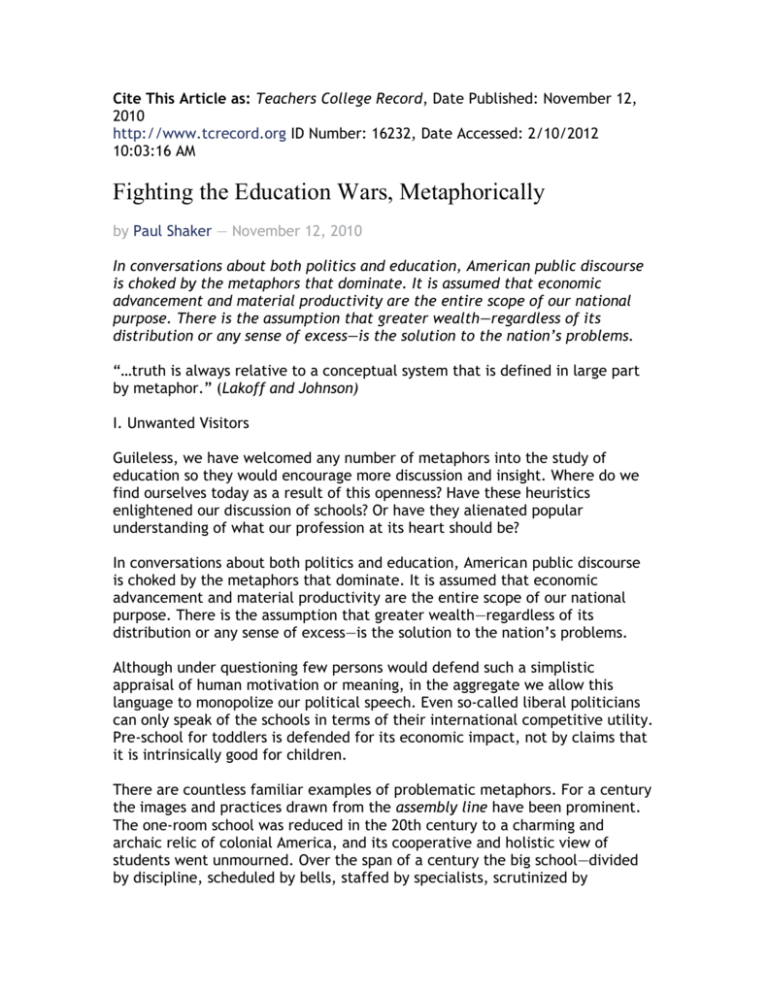
Cite This Article as: Teachers College Record, Date Published: November 12, 2010 http://www.tcrecord.org ID Number: 16232, Date Accessed: 2/10/2012 10:03:16 AM Fighting the Education Wars, Metaphorically by Paul Shaker — November 12, 2010 In conversations about both politics and education, American public discourse is choked by the metaphors that dominate. It is assumed that economic advancement and material productivity are the entire scope of our national purpose. There is the assumption that greater wealth—regardless of its distribution or any sense of excess—is the solution to the nation’s problems. “…truth is always relative to a conceptual system that is defined in large part by metaphor.” (Lakoff and Johnson) I. Unwanted Visitors Guileless, we have welcomed any number of metaphors into the study of education so they would encourage more discussion and insight. Where do we find ourselves today as a result of this openness? Have these heuristics enlightened our discussion of schools? Or have they alienated popular understanding of what our profession at its heart should be? In conversations about both politics and education, American public discourse is choked by the metaphors that dominate. It is assumed that economic advancement and material productivity are the entire scope of our national purpose. There is the assumption that greater wealth—regardless of its distribution or any sense of excess—is the solution to the nation’s problems. Although under questioning few persons would defend such a simplistic appraisal of human motivation or meaning, in the aggregate we allow this language to monopolize our political speech. Even so‐called liberal politicians can only speak of the schools in terms of their international competitive utility. Pre‐school for toddlers is defended for its economic impact, not by claims that it is intrinsically good for children. There are countless familiar examples of problematic metaphors. For a century the images and practices drawn from the assembly line have been prominent. The one‐room school was reduced in the 20th century to a charming and archaic relic of colonial America, and its cooperative and holistic view of students went unmourned. Over the span of a century the big school—divided by discipline, scheduled by bells, staffed by specialists, scrutinized by measurements, and rated by productivity—became the unchallenged norm. (If only we could departmentalize the elementary school, our transformation would be complete.) Watchwords are bigger, faster, more compartmentalized and specialized, managed by micro‐objectives, standardized, one size fits all. With the factory ideal comes a set of economic values. Students and families are customers, and they should have educational choice in a free market. The best schools emerge in this competitive environment, and the losers go out of business. Professional preparation and licenses are an impediment to market flow. In a deregulated environment the highest quality services triumph via the invisible hand. Lowering cost becomes a high priority that is achieved by revolving door faculties, reduction of benefits, shuttling special needs students to someone else’s ledger, and narrowing the scope of schooling. Quality is easy to determine since accountability tells us which schools are the best through high stakes testing and school ranking. We are making a science of education by applying the practices of corporate suites to the schools. Simplify quality to what can be put into numbers cheaply and insist on the sole significance of this criterion. Ignore what doesn’t fit the model. The burden of pushing back on this general sentiment is not to be underestimated. As in the frustration of a dream, the advocates of humane values seem unable to speak. Generally these perspectives are quarantined from media platforms while generals, business executives, and politicians hold forth about a profession they have never practiced. The documentary “Waiting for ‘Superman’” represents many of the worst of these phenomena, while the response of Randi Weingarten, president of the AFT, is a valiant effort to redress this disinformation. Look at the rosters of news programs and Charlie Rose and count how few bona fide educators appear. One consequence of their media monopoly is that visitors to education, such as Cathleen Black, chairman of Hearst Magazines, have come to lead districts, including in this case that of New York City. Meanwhile, among all the metaphors borrowed and applied by non‐educators, the core symbols of education are gradually obscured and forgotten. In loco parentis, for example, entails a selfless, caring relationship extended by teachers as we have seen in their behavior at each Columbine‐type school attack. The common school, educating all classes and kinds of children in a community, is a notion at odds with stratification by vouchers and isolation via home schooling. The school as a microcosm of society is a favorite image of John Dewey. Students have a voice within the school and their parents work through elected boards to make local schools laboratories for local democracy. We also inherit from Dewey the notion of growth, a continuous process describing education as driven by further learning. Education is not characterized by mastery or competence, but by an open‐ended attitude toward living. The word education itself is deeply symbolic of a process that recognized the significance of the learner, whose learning was more a drawing forth of prior student experience than a pouring out of teacher knowledge. All this fits with the overarching goal of self-realization, the development of individual psychological potential and the spiritual fulfillment of each person. Economic and social ends are not forgotten; they are subsumed into what Rousseau called the social man. Educators have explicit values that weren’t drawn from the marketplace, or sports, or war. Productivity, ranking, competition, efficiency, accountability, markets, and value‐added are not our professional guideposts. Testing is a tool for teaching, not an end in itself. Students get only one chance to go through school. For this reason, our tradition opposes having families gamble their children’s education in a sector of society characterized by caveat emptor. The approach of educators has been to provide through regulation and professional practice a guaranteed standard in all schools. At the same time, other caregivers are to provide the home and community life children require. For our part, we understand and follow values such as democracy, individuality, civility, kindness, cooperation, respect, compassion, egalitarianism, and inspiration. We build schools around our own, un‐borrowed values. Schools that embody such values remain the type that parents with the most freedom of choice typically prefer for their own children. The problem remains, however, that even at our own conferences the public voices we hear are largely captured by these visiting metaphors we welcomed into our house. We hear too little of our own best language and imagery. We hear even less of the Deweyan principle that schools must serve students as ends in themselves. Too few say that we should act with a creative emphasis on children’s holistic development rather than seeing our students as means to economic competitiveness. II. Taking Care of Education In Metaphors We Live By (1980) Lakoff and Johnson suggest a metaphor—love is a collaborative work of art—to stimulate a fresh discussion of society so that new meanings and new associations come forward. What if we adapted this to our purposes by claiming education is a collaborative work of art? Here are some of the entailments that arise: Education is creative. Education takes both familiar and unforeseen forms. Education is aesthetic, affective, and value‐driven. Education is holistic in its relation to persons. Education takes time. Education requires active involvement by all parties. Education is conducted by persons with great skill and preparation. Education is characterized by creativity. Education emphasizes cooperation, not competition. Education ultimately is spiritual, not material. Education is ultimately beyond measurement in its effects. Education involves dedicated effort by all parties. Education requires resources. Education can occur only after students’ survival needs are met. The problem of metaphor in education is one part of a general capture of American discourse by language that is skillfully sold by those who work at this task for hire. Since the dawn of the public relations and advertising industries, clever operatives in politics and the marketplace have employed the power of metaphor and narrative to shape public consciousness for their own purposes. Gradually in education the context of discussion has been similarly shifted so that our cardinal values are little spoken of and center stage is occupied by endless debates rooted in testing and ranking. The communal aspirations of patriotism and social justice are lost in an environment of material acquisitiveness and scorn for those whom society leaves behind and their teachers. Exploiting the psychology of ego development, those who sell “words that work” have successfully introduced a lexicon of epithets and buzz‐words to divide society into camps of “right” and “left” that under scrutiny retain little meaning. In the process, our public dialogue rarely goes beyond labeling and glib sloganeering. What passes for debate is little more than an invocation of the metaphors that caricature analysis instead of deepening it. This is what Piaget calls “false accommodation.” “Waiting for ‘Superman’” illustrates this breakdown in analysis by, for example, idealizing schools in Finland and Canada, where teachers unions are a vital force, while vilifying teachers unions in America as a key obstacle to reform. Another failure of critical thought is illustrated by a sports metaphor— fire the coach—being seamlessly translated into closing schools and dismissing principals and teachers. This passes for reform. Analysis also fails when little is said about how American childhood poverty affects education and, correspondingly, how successful our schools are with children who have a suitable family foundation. Even less is said about two centuries of contributions by the public schools to building this society, including its research capacity. A number of pathways remain open to those who wish to restore the best of progressive education. There is the very passive approach of waiting for a crisis greater than the one of 2008 to disrupt the status quo. Among the more active responses is speaking out in venues of all types with our own distinctive language and imagery to present our vision of society and schools. At the same time our organizations should be pressed to use their resources to promote the viewpoint of educators and guide the quest for metaphors that transcend the current debate and create a vision of our profession worthy of our rising generations. Cite This Article as: Teachers College Record, Date Published: November 12, 2010 http://www.tcrecord.org ID Number: 16232, Date Accessed: 2/10/2012 10:03:16 AM







